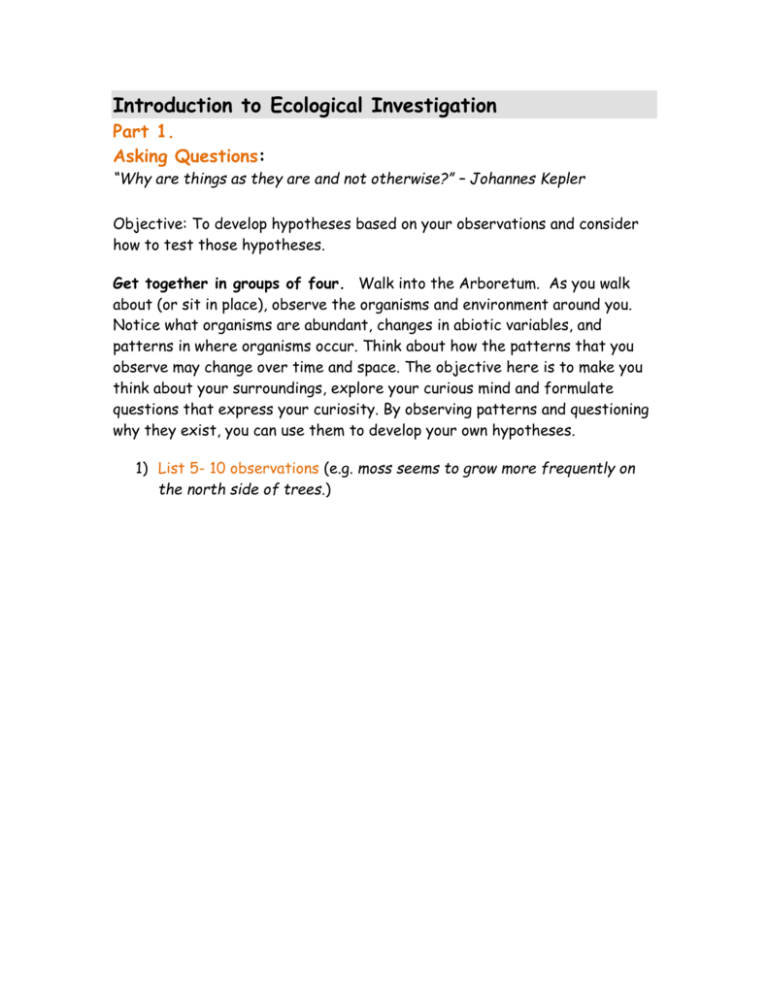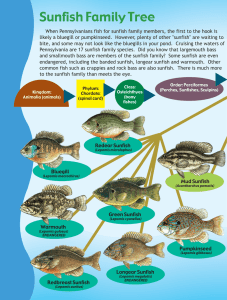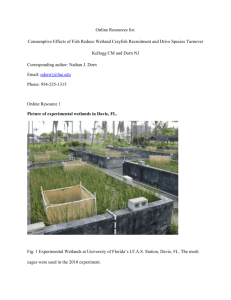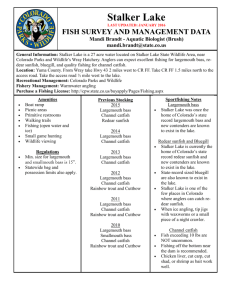MEASURING ECOLOGICAL PARAMETERS AND PROCESSES
advertisement

Introduction to Ecological Investigation Part 1. Asking Questions: “Why are things as they are and not otherwise?” – Johannes Kepler Objective: To develop hypotheses based on your observations and consider how to test those hypotheses. Get together in groups of four. Walk into the Arboretum. As you walk about (or sit in place), observe the organisms and environment around you. Notice what organisms are abundant, changes in abiotic variables, and patterns in where organisms occur. Think about how the patterns that you observe may change over time and space. The objective here is to make you think about your surroundings, explore your curious mind and formulate questions that express your curiosity. By observing patterns and questioning why they exist, you can use them to develop your own hypotheses. 1) List 5- 10 observations (e.g. moss seems to grow more frequently on the north side of trees.) 2) Choose four of these observations and transform them into questions that ask why or how these observations came to be. For example, (assuming data indicate that in fact, moss grows more frequently on the north side of trees) why does moss grow more frequently on the north side of trees? 3) Now, transform two of these questions into functional hypotheses. A functional hypothesis in ecology relates to the cause of the structural difference observed. E.g. Moss grows on the north side of trees because it is shaded from the sun. Remember, a hypothesis is a potential explanation for your observation. 4) Choose one of your hypotheses and identify some predictions that would test your hypothesis. A prediction states a specific relationship between variables. If data collect indicate that this relationship exists, then hypothesis is supported. E.g. moss will be more frequent in shady areas deep within the forest, than in sunny areas along the edge of forest. If this is true, then it lends support to the hypothesis and we have greater confidence that it is correct (note that the hypothesis is not proven as there is always the possibility that an alternate hypothesis explains why moss grows on the north side of trees). Hypothesis: Predictions: Experimental description. Group members: Part 2. Excel Assignment: Objective: To formulate hypotheses and use appropriate statistical analyses to test the hypothesis formulated, to use Excel to do data calculation, presentation, and analysis. In the paragraphs below, four different aquatic research questions addressed by students and faculty here in recent years are described. For each of these scenarios, 1) state the overall hypothesis and give a specific prediction, 2) use Excel to test that prediction with an appropriate statistical analysis and create a figure in Excel that displays the results and 3) briefly summarize the findings in a narrative. You should create a Word document that gives the hypotheses, predictions and statistical results, displays the figure and provides the findings narrative. (Although you will prepare your statistical analysis in an Excel file, each group will submit a SINGLE WORD DOCUMENT via Turnitin.com. Your word document will include both part 1 and part 2 of this assignment). Elimia sp. Densities – Ellen Winant Ellen Winant looked at the densities of a common species of freshwater snail in the genus Elimia. She hypothesized that snail abundance would be higher in streams with higher conductivity (a measure of the ion concentration of the water). Since snails require minerals (primarily calcium) to form their shells, it seems reasonable to predict that streams with higher ion availability would support more snails. To test her idea, Ellen sampled snails in two streams with differing conductivities, Stamp Creek (a low conductivity stream) and Two Run Creek (a high conductivity stream). In each stream, she randomly selected 20 points. At each point she used a Surber sampler to collect snails from a 0.09 m2 area. The data she collected in August, 2009 is given in the worksheet entitled “Snail Densities”. Species Richness – Jimi Reece Jimi Reece was interested in examining the relationship between the number of fish species in a stream (species richness) and the level of urban development in the watershed draining that stream. He hypothesized that as urban development (as measured by road density = the length of roads per square kilometer) increased, species richness would decrease. A complicating factor in his analysis was that (all other factors being held constant) as watershed area increases, the number of species we expect to find also increases. To account for this, he first conducted a regression analysis on a large data set from sites throughout the northwest Atlanta metropolitan area to develop a predictive equation for the number of species of fish as a function of watershed area. From that same data set, he selected 16 separate sites with differing levels of urban development. For each of the sites, he quantified road densities using ARC-INFO, a geographic information systems software package. He then estimated the expected species richness based on the watershed size. He then subtracted the observed value for that site (obtained from field samples) from the predicted value (obtained from the regression analysis) to generate what is known as a residual. If the residual is negative, observed species richness is lower than expected, if it positive, richness is higher than expected. The residual is the estimate of species diversity (that has been corrected for watershed area) that you should compared to level of road density. The data for the sixteen sites he examined is in the worksheet “Urban Fish”. Lake Allatoona – Dr. Dirnberger Dr. Dirnberger has conducted a number of differing studies on Lake Allatoona since he came to Kennesaw. In one of his recent studies, he realized that it would be useful if he could predict lake temperatures in August based on the air temperatures experienced over the previous months. He had a good data set for August lake temperatures (measured at 4 m in the same location in the lake) for the period from 1988 through 1992 and a second set of data from 1997 through 2003. He was able to estimate the average air temperature for the months of June, July and August from National Weather Service data. The data appears in the “Lake Allatoona Temperatures” worksheet. Last summer’s average temperature was 25.91°. What would Dr. Dirnberger expect the August water temperature to be and how confident should he be in that prediction? Sunfish Habitat Preference – Eddie Leonard Eddie Leonard was interested in the types of habitats used by sunfish in the genus Lepomis. As a fisherman, he knew that he was more successful catching sunfish during the day in deep, slow moving areas, but these areas seemed to be less productive during the night. He wondered if sunfish actually preferred deeper, slower moving areas during the day. Separately, he also wondered if sunfish preferred deeper, slower moving areas during the night. To explore these ideas, he randomly selected 45 points in Stamp Creek. At each of the 45 points, he measured water depth (in cm) and water velocity (in cm/s). After taking the measurement, he placed a construction flag at that location. After all the habitat points were measured and marked, he entered the stream at the downstream flag and using a mask and snorkel, did an instantaneous count of the number of sunfish within 1 m of each of the flags. He did counts both 2 hours before sunset and 2 hours after sunset (using a dive light). He collected data on two separate occasions. The data he collected is given in the worksheet entitled “Lepomis preference”. He divided his depth measurements into shallow (less than 20 cm) and deep (greater than or equal to 20 cm) and his velocity measurements into slow (less than 10 cm/s) and fast (> 10 cm/s). Combining these gives four categories, slow-shallow, fast-shallow, slow-deep, fast-deep. The table entries give the number of habitat points that fall in each of these categories (available) and the number of sunfish seen using those points (observed).











